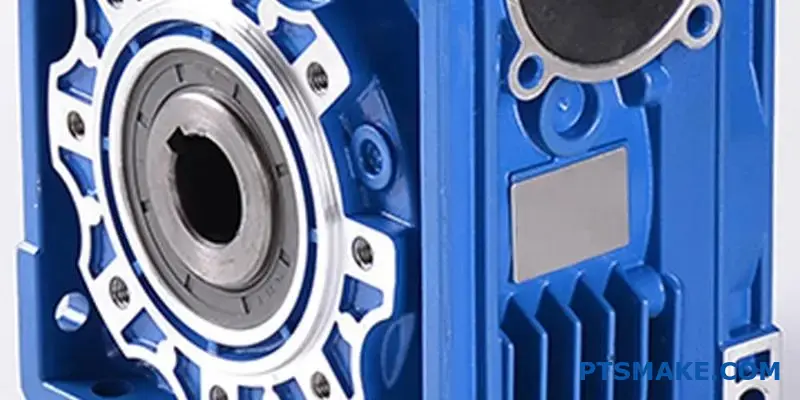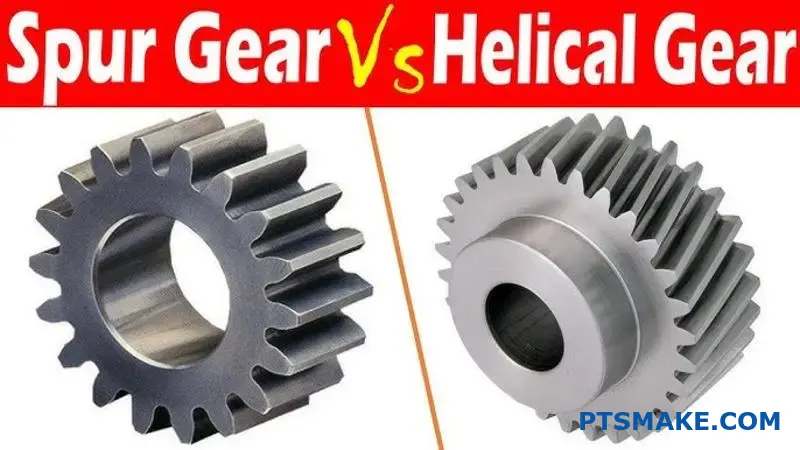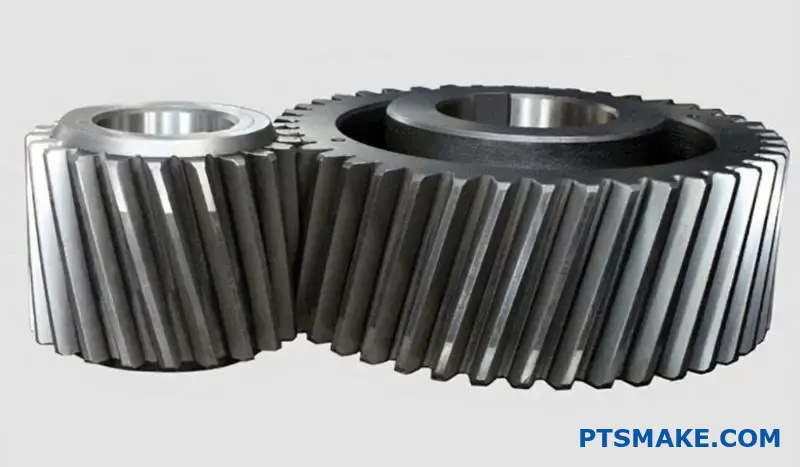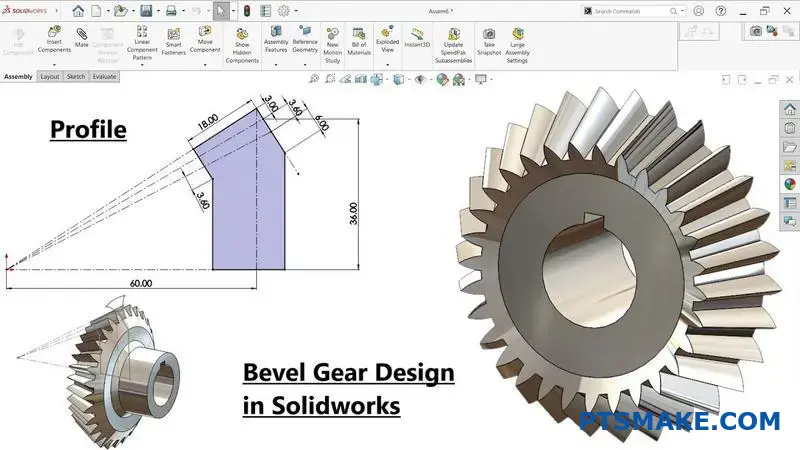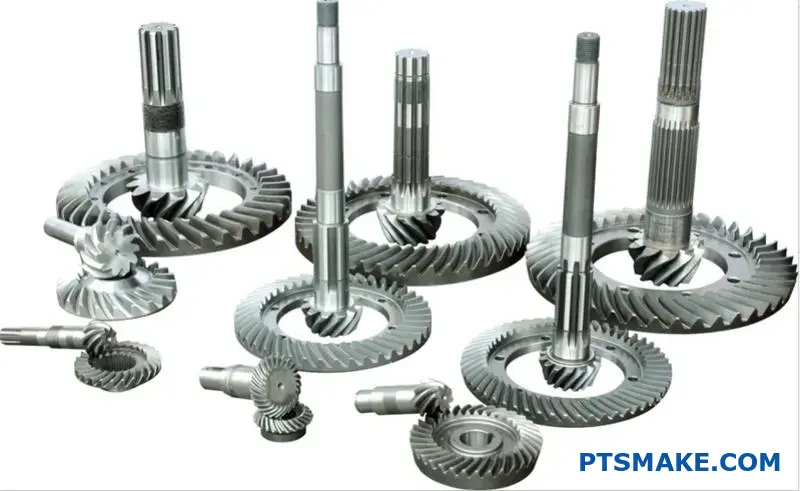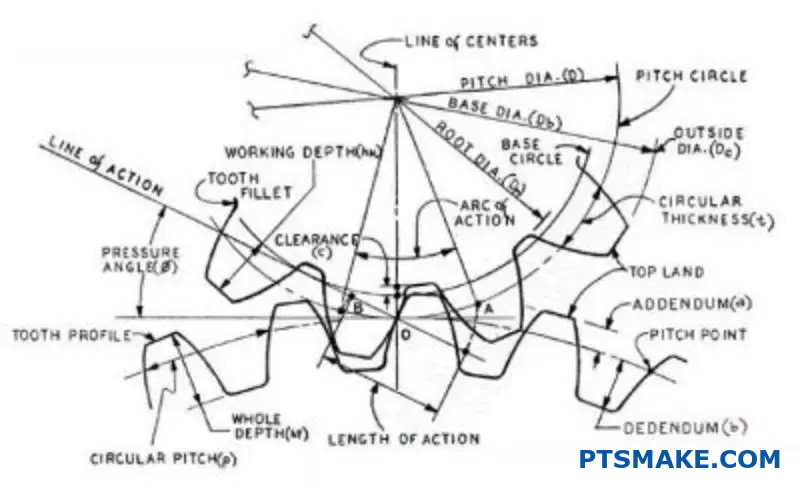How to Choose an Aluminium Profile?
Selecting the right aluminium profile can be overwhelming with so many options available. The wrong choice could lead to project delays, structural failures, or unnecessary expenses. Many engineers and designers struggle with balancing cost, strength requirements, and application-specific needs.
To choose the right aluminium profile, assess your application needs first, then consider factors like load requirements, environmental conditions, connection methods, and surface finish options. Match these requirements with the appropriate profile series and specifications.
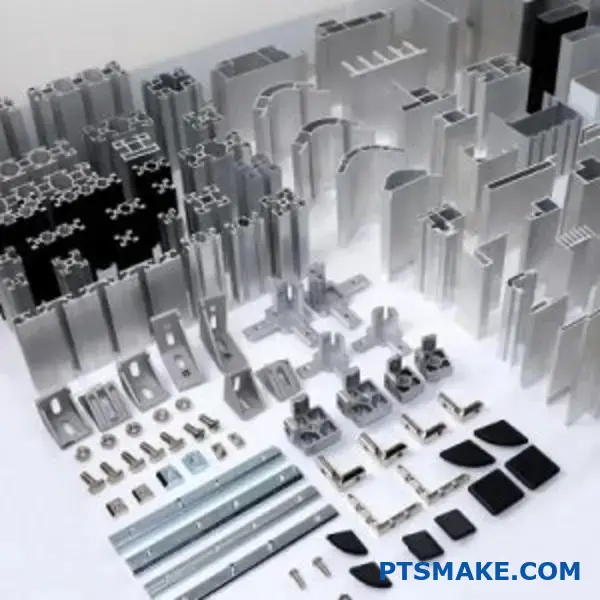
I’ve guided hundreds of clients through aluminium profile selection at PTSMAKE, and I’ve seen how the right choice can make or break a project. In this guide, I’ll share what matters most when selecting profiles for your specific needs and help you avoid costly mistakes that could impact your project’s success.
Does Aluminium Profile Rust?
Ever specified aluminum thinking it’s immune to environmental effects, only to see changes later? Confused if that white powder or pitting on the surface is actually rust?
Technically, aluminium profiles don’t ‘rust’ in the same way iron or steel does. Rust specifically refers to iron oxide. However, aluminium does corrode, forming a protective layer of aluminium oxide instead.
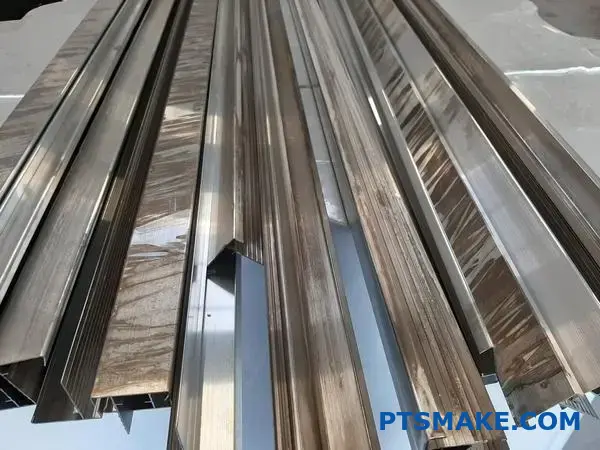
Let’s dive deeper into this common question. While aluminium doesn’t form the reddish-brown flaky rust seen on steel, it undergoes its own form of oxidation. Understanding this difference is crucial when selecting materials, especially for demanding applications.
Understanding the Difference: Rust vs. Corrosion
Rust is the common term for the corrosion of iron and its alloys, like steel. It results from the reaction of iron with oxygen in the presence of water or air moisture, forming iron oxides. Aluminium, on the other hand, reacts with oxygen very quickly to form aluminium oxide.
The Protective Oxide Layer
How it Forms
When aluminium is exposed to air, a very thin, hard layer of aluminium oxide (Al₂O₃) forms almost instantly on the surface. This layer is strongly bonded to the aluminium beneath it.
Its Benefits
Unlike iron rust, which is porous and flakes off, exposing fresh metal to further rusting, the aluminium oxide layer is dense and adheres firmly. This layer acts as a natural barrier, protecting the underlying aluminium from further significant corrosion under many conditions. This self-protecting feature is one of aluminium’s key advantages.
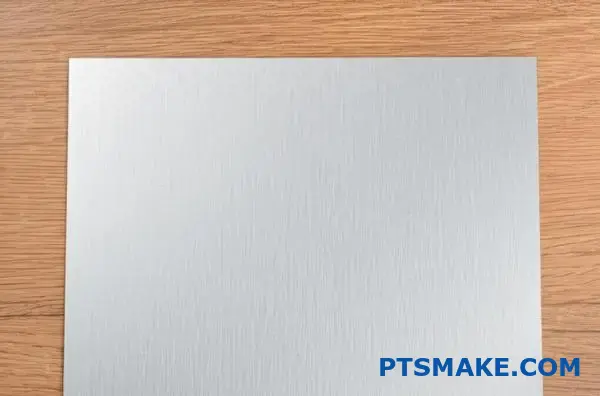
Factors Influencing Aluminium Corrosion
While naturally resistant, aluminium is not completely immune to corrosion, especially under specific conditions.
Environmental Conditions
Exposure to certain environments can break down the protective oxide layer and lead to corrosion:
- High Salinity: Coastal areas or exposure to de-icing salts can cause pitting corrosion.
- Extreme pH: Very acidic or alkaline environments (pH < 4 or > 9) can attack the oxide layer.
- Pollutants: Industrial pollutants like sulfur dioxide can accelerate corrosion.
- Contact with Dissimilar Metals: This can lead to galvanic corrosion1 if moisture is present.
Aluminium Alloys
The specific aluminium alloy used also impacts corrosion resistance. Pure aluminium has excellent resistance, but alloying elements added to enhance strength or other properties (common in custom aluminum profiles) can sometimes slightly reduce it. At PTSMAKE, based on past projects, we help clients select alloys like the 6000 series (e.g., 6061 or 6063) which offer a good balance of strength, workability, and corrosion resistance for many structural and architectural applications.
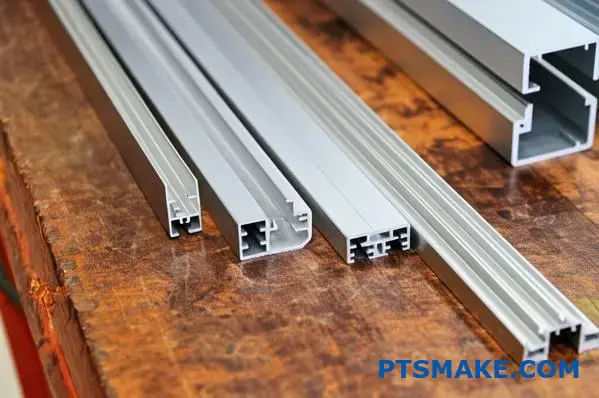
Here’s a simple comparison:
| Feature | Iron Rust (e.g., on Steel) | Aluminium Corrosion (Oxide Layer) |
|---|---|---|
| Chemical Name | Iron Oxides | Aluminium Oxide |
| Appearance | Reddish-brown, flaky | White/grey powder, pitting |
| Layer Property | Porous, non-protective | Dense, generally protective |
| Effect on Metal | Progressive degradation | Often self-limiting |
Understanding these nuances helps in designing durable products and selecting appropriate surface treatments if needed for specific custom aluminum profiles.
Is an Aluminium Profile Strong?
Ever wondered if aluminium is truly up to the task for your structural needs? Does the lighter weight make you second-guess its ability to handle demanding loads, potentially risking project integrity?
Yes, aluminium profiles can be exceptionally strong, especially considering their low density. The actual strength largely depends on the specific alloy chosen, the profile’s geometric design, and any heat treatments applied.
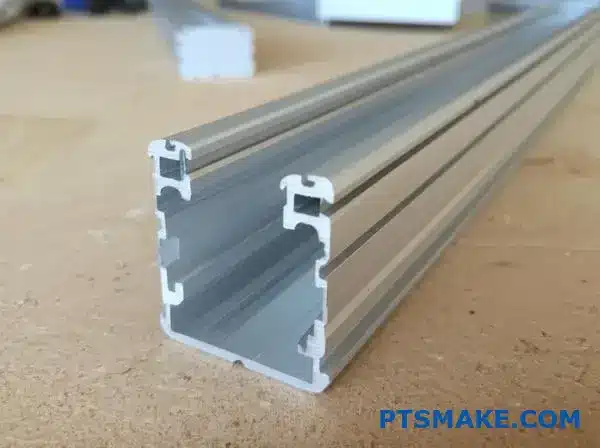
Aluminium’s reputation for being lightweight sometimes overshadows its potential for strength. But strength isn’t just about brute force; it’s often about the strength-to-weight ratio, where aluminium excels. Let’s break down what makes an aluminium profile strong.
Factors Defining Strength
Several key elements determine how strong a specific aluminium profile will be. Understanding these helps in selecting the right material for your application.
Alloy Composition
Aluminium is almost always alloyed with other elements (like silicon, magnesium, copper) to enhance specific properties. At PTSMAKE, we often work with the 6000 series (like 6061 and 6063) for custom aluminum profiles because they offer a great combination of strength, machinability, and corrosion resistance suitable for many structural and industrial uses.
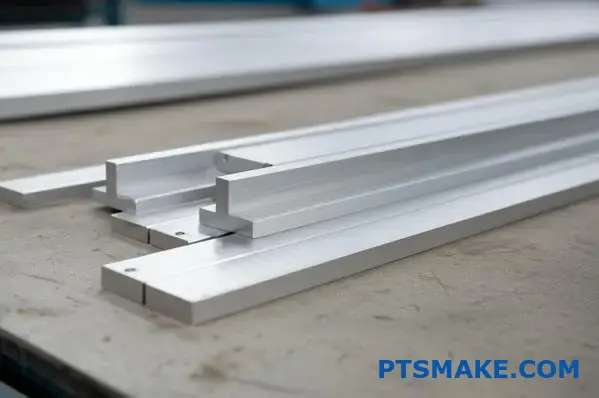
Profile Geometry
The shape of the profile significantly impacts its rigidity and load-bearing capacity. Intricate designs with internal supports or specific cross-sections (like I-beams or T-slots) are engineered to maximize strength in certain directions while optimizing material usage. A hollow square tube will behave differently under load than a solid bar of the same outer dimensions.
Heat Treatment (Temper)
This is a crucial factor. Processes like heating and cooling aluminium alloys can dramatically alter their mechanical properties. Common tempers like T5 or T6 significantly increase the Yield Strength2 and ultimate tensile strength compared to the base alloy in its annealed (O) state.
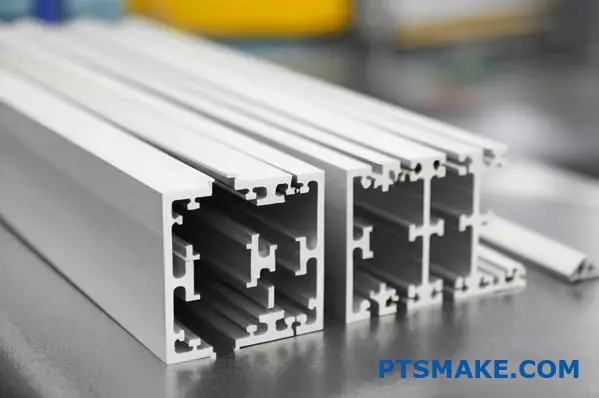
Strength Compared to Steel
It’s common to compare aluminium to steel. While steel is generally denser and stronger in absolute terms, aluminium profiles often win when weight is a critical factor.
| Property | Aluminium (6061-T6) | Mild Steel (A36) | Unit | Note |
|---|---|---|---|---|
| Density | ~2.70 | ~7.85 | g/cm³ | Aluminium is about 1/3 the weight |
| Yield Strength | ~276 | ~250 | MPa | Measures resistance to permanent bending |
| Ultimate Tensile Str | ~310 | ~400-550 | MPa | Measures point of breaking |
| Strength-to-Weight | Higher | Lower | Relative | Aluminium often preferred for mobility |
Based on project experience, choosing between aluminium and steel often comes down to application specifics – is absolute strength paramount, or is a high strength-to-weight ratio more critical? For many applications requiring custom aluminum profiles, aluminium provides sufficient strength with significant weight savings.
What Are the Advantages of Aluminum Profile?
Have you ever struggled with materials that are too heavy, prone to rust, or limit your design possibilities? Selecting the wrong material can lead to higher costs and compromised performance.
Aluminum profiles offer significant advantages, including being lightweight, highly resistant to corrosion, having an excellent strength-to-weight ratio, exceptional design flexibility through extrusion, and being highly recyclable, making them a versatile and sustainable choice for many applications.
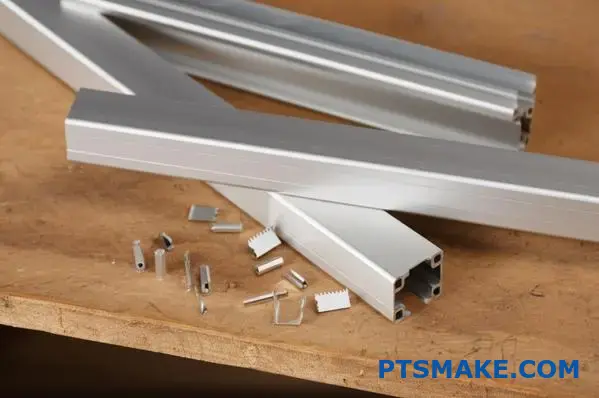
Let’s explore these benefits in more detail. Understanding why aluminum profiles are favored in so many industries, from construction to electronics, can help you make informed decisions for your own projects. At PTSMAKE, we frequently leverage these advantages for our clients’ demanding applications.
Lightweight Nature
One of the most well-known benefits is aluminum’s low density. It’s roughly one-third the weight of steel. This makes aluminum profiles easier and cheaper to transport, handle, and install. In applications like automotive or aerospace, this weight reduction translates directly into fuel efficiency and improved performance. Think about manual handling – lighter components mean less strain and potentially faster assembly.
Excellent Corrosion Resistance
Have you noticed how aluminum doesn’t rust like iron or steel? Aluminum naturally forms a thin, tough layer of aluminum oxide on its surface when exposed to air. This passivation3 layer protects the metal underneath from further oxidation and most types of corrosion. While harsh environments can still affect it, for many common applications, this inherent resistance is a major plus, reducing the need for protective coatings.
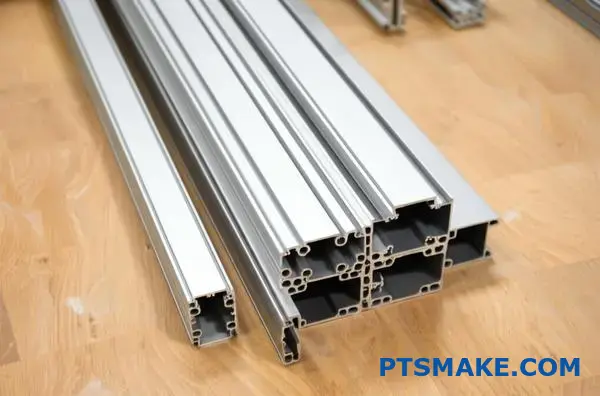
High Strength-to-Weight Ratio
While steel might be stronger in absolute terms, aluminum often wins when you consider strength relative to its weight. Certain aluminum alloys, especially after heat treatment (like the T6 temper commonly applied to 6061 alloy), achieve impressive strength. This makes aluminum profiles ideal for structural applications where minimizing weight is critical without significantly sacrificing load-bearing capacity. In past projects at PTSMAKE, we’ve seen this benefit utilized heavily in robotics and automation frameworks.
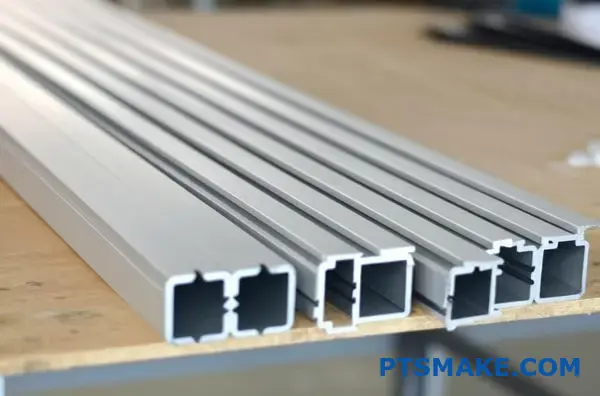
Design Flexibility and Extrudability
Aluminum is highly malleable and easily extruded. The extrusion process allows for the creation of intricate and complex cross-sectional shapes tailored precisely to specific functions. This means features like T-slots, screw ports, or cooling fins can be integrated directly into the profile design. This capability opens up vast possibilities for creating optimized and efficient custom aluminum profiles, often reducing part count and simplifying assembly compared to fabricated steel structures.
Other Key Advantages
Beyond the main points, aluminum profiles offer several other benefits:
| Advantage | Description | Relevance |
|---|---|---|
| Recyclability | Aluminum can be recycled repeatedly without losing its quality. | Environmentally friendly, sustainable choice. |
| Thermal Conductivity | Conducts heat very well, about twice as effectively as steel. | Useful for heat sinks and heat exchange apps. |
| Electrical Conductivity | Good conductor, though not as good as copper. | Used in electrical busbars and components. |
| Non-Magnetic | Does not interfere with magnetic fields. | Important for sensitive electronic enclosures. |
| Ease of Machining | Generally easy to machine, drill, cut, and fabricate. | Simplifies secondary processing operations. |
These combined advantages make aluminum profiles, including custom aluminum profiles, a go-to solution across a vast spectrum of industries and applications.
What Quality Control Measures Ensure Profile Integrity?
Worried that your custom aluminum profiles might not meet the strict specifications needed? Concerned about hidden defects impacting performance or leading to costly failures down the line?
Ensuring integrity involves a multi-stage approach: strict raw material verification, precise extrusion process monitoring, in-process checks for dimensions and tolerances, thorough post-extrusion inspections (visual, mechanical testing), and final quality audits before shipment. Partnering with a capable manufacturer is key.
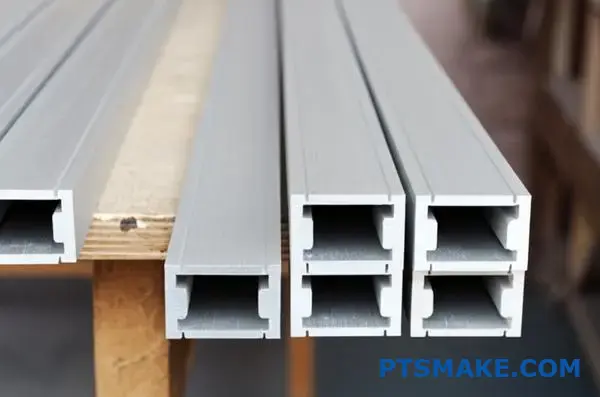
Ensuring the quality of custom aluminum profiles isn’t about a single check; it’s a comprehensive system woven throughout the manufacturing process. From the moment raw materials arrive to the final packaging, every step needs careful oversight. Let’s break down the critical quality control points we focus on at PTSMAKE, based on our experience delivering high-precision parts.
Raw Material Verification
Quality starts with the input. Before extrusion even begins, the aluminum billet’s composition must be confirmed.
Does it match the specified alloy (like 6061 or 6063)? We verify this through material certifications from the supplier and sometimes conduct our own confirmatory analysis using spectrometry. Using the wrong alloy can drastically affect strength, corrosion resistance, and machinability.
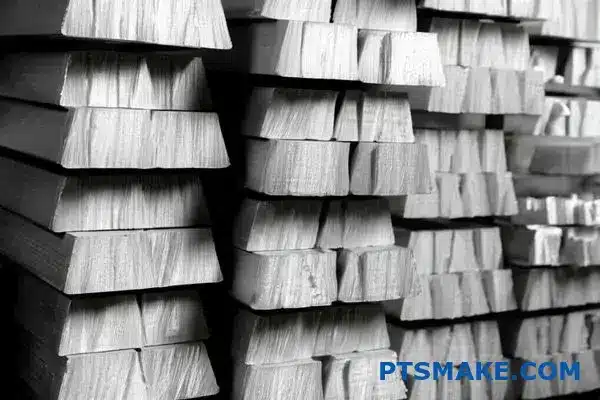
In-Process Monitoring
Controlling the extrusion process itself is vital. Key parameters include:
- Die Condition: Ensuring the extrusion die is precisely made and maintained.
- Temperature Control: Monitoring billet preheat and extrusion temperatures. Incorrect temperatures affect the material’s properties and surface finish.
- Extrusion Speed: Maintaining a consistent speed for uniform results.
Dimensional Accuracy Checks
This is where precision matters most for custom aluminum profiles. Checks are performed both during and after extrusion.
Operators use calipers, micrometers, and profile projectors for initial checks right after extrusion. For complex geometries or tight tolerances, Coordinate Measuring Machines (CMM) provide highly accurate 3D measurements. Consistent dimensional accuracy relies on skilled operators using advanced metrology4 tools.
Critical Tolerances
We pay special attention to dimensions crucial for assembly or function, ensuring they fall within the specified tolerance range agreed upon with the client.
Post-Extrusion Inspection & Testing
Once profiles are cooled and cut, further checks are essential.
Visual Inspection
Profiles are examined for surface defects like scratches, die lines, inconsistencies in finish, or contamination.
Mechanical Testing
Depending on requirements, tests like hardness checks (e.g., Rockwell or Brinell) and tensile tests are performed on samples to verify mechanical properties like strength and ductility meet specifications.
Here’s a simplified overview of typical checks:
| Checkpoint Stage | Key Focus Areas | Tools Used |
|---|---|---|
| Raw Material | Alloy Composition Verification | Spectrometer, Certifications |
| During Extrusion | Temperature, Speed, Die Condition | Sensors, Pyrometers |
| Post-Extrusion (Hot) | Critical Dimensions Sample Check | Calipers, Profile Projector |
| Post-Extrusion (Cool) | Full Dimensional Check, Visual Defects | CMM, Calipers, Visual Inspection |
| Final Quality Audit | Mechanical Properties, Surface Finish, Packing | Hardness Tester, Tensile Tester |
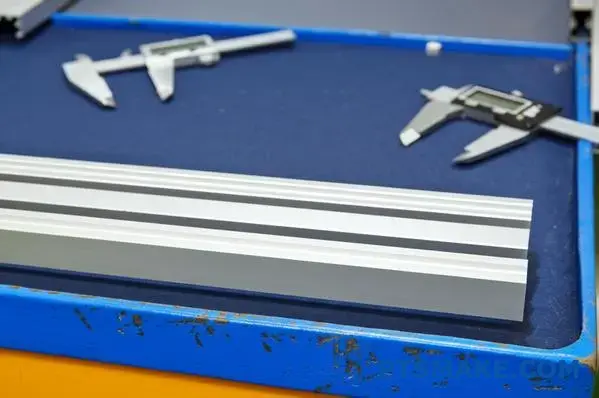
Final Audit and Documentation
Before shipment, a final quality audit confirms all previous checks passed and that the profiles meet all order specifications, including packaging requirements. Comprehensive documentation provides traceability and assurance for the client. This systematic approach ensures the custom aluminum profiles you receive consistently meet your quality expectations.
What Are the Cost Factors for Custom Aluminum Profiles?
Ever received a quote for custom aluminum profiles and wondered why the numbers vary so much? Feeling unsure about what really drives the final price and how to manage your budget effectively?
The primary cost factors for custom aluminum profiles include the raw material (aluminum ingot price), complexity of the profile design, tooling (die creation), required tolerances, choice of alloy and temper, surface finish, order quantity, and any secondary processing needed.
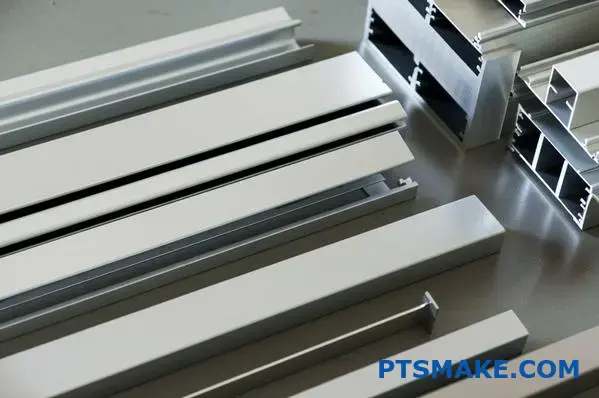
Understanding the breakdown of these costs is crucial for effective project planning and supplier negotiation. It’s not just about the weight of the aluminum; several elements contribute significantly to the final invoice. Let’s delve into the key drivers I often discuss with clients at PTSMAKE to ensure transparency and find cost-effective solutions.
Raw Material Cost: The Foundation
This is often the most significant portion of the cost. Aluminum ingot prices fluctuate based on global market supply and demand, often tracked by indices like the London Metal Exchange (LME). The specific alloy chosen also matters. Standard alloys like 6063 or 6061 are generally more cost-effective than high-strength or specialized alloys (e.g., 7000 series) due to ingredient costs and availability.
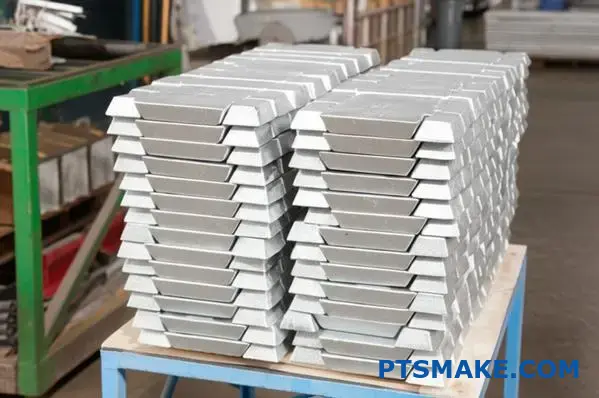
Profile Design Complexity and Tolerances
How intricate is your design? Complex shapes with very thin walls, sharp internal corners, or multiple hollow sections require more sophisticated dies and slower extrusion speeds. This increases manufacturing difficulty and potentially the scrap rate, driving up costs. Similarly, demanding tighter tolerances than standard requires more precise process control and extensive quality checks, adding to the overall expense. It’s always a balance between design intent and manufacturing feasibility.
Tooling (Extrusion Die) Investment
Creating the extrusion die is typically a one-time cost, often referred to as Non-Recurring Engineering5 (NRE). The cost of the die itself depends heavily on the profile’s complexity, size, and the type of steel used for the die. More intricate profiles require more complex (and expensive) dies. While this is an upfront investment, the die’s lifespan affects long-term costs for repeat orders.
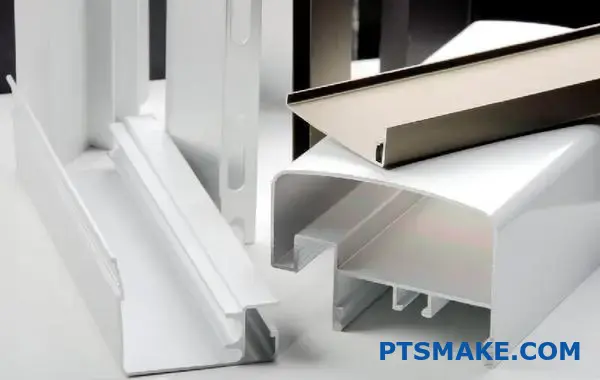
Surface Finish and Secondary Operations
Do your custom aluminum profiles need a specific look or additional processing?
- Surface Finishes: Anodizing (clear or color), powder coating, painting, polishing, or brushing all add steps and costs. Complex masking for selective finishing further increases this.
- Secondary Operations: Cutting to specific lengths, drilling holes, tapping threads, CNC machining features, bending, or welding adds labor and machine time, impacting the per-piece price.
Order Quantity
Economies of scale play a big role. Larger production runs generally result in a lower cost per unit because setup times and tooling costs are amortized over more parts. Small prototype runs will inevitably have a higher per-piece cost compared to mass production volumes.
Here’s a simplified look at relative cost impacts:
| Cost Factor | Typical Cost Impact | Notes |
|---|---|---|
| Raw Material (Alloy) | High | Fluctuates with market, alloy type matters |
| Profile Complexity | Medium to High | Affects die cost and extrusion speed |
| Tooling (Die NRE) | Medium (One-Time) | Complexity is key driver |
| Tight Tolerances | Medium | Requires more process control & QC |
| Surface Finish | Low to High | Depends heavily on type and complexity |
| Secondary Operations | Low to High | Depends on number and type of operations |
| Order Quantity | High (Inverse) | Larger quantity generally means lower unit cost |
By understanding these factors, you can have more informed discussions about your custom aluminum profiles project, potentially identifying areas for cost optimization without compromising essential requirements.
How Can You Ensure Long-Term Supplier Reliability?
Found a great supplier for your custom aluminum profiles, but how do you ensure they stay great? Worried that initial quality or communication might fade over the months or years?
Ensuring long-term supplier reliability involves continuous communication, setting clear expectations, monitoring performance through defined metrics, conducting periodic reviews or audits, and actively fostering a collaborative partnership rather than a purely transactional one.
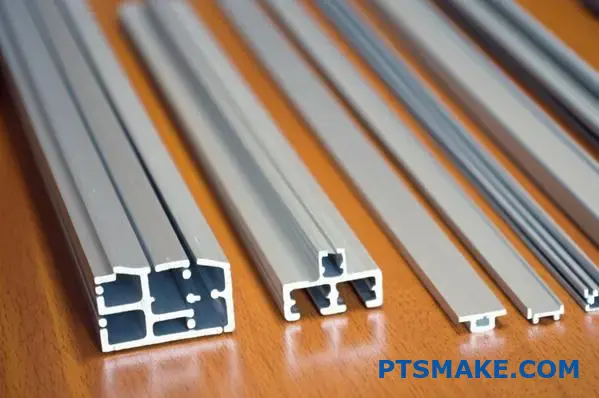
Selecting a supplier is just the first step; maintaining that relationship and ensuring consistent performance requires ongoing effort. It’s about building trust and verifying results over the entire lifecycle of your engagement. Based on experiences fostering long-term partnerships at PTSMAKE, here’s how you can build a foundation for lasting reliability with your custom aluminum profiles provider.
Establish Clear Communication Channels
Effective communication is the bedrock of any successful partnership. Don’t wait for problems to arise.
Regular Check-ins
Schedule regular meetings (virtual or in-person) to discuss ongoing projects, forecasts, and any potential challenges. This keeps both parties aligned and allows for proactive problem-solving.
Defined Points of Contact
Ensure you know who to contact for specific issues (e.g., technical questions, quality concerns, scheduling updates). This streamlines communication and avoids confusion.
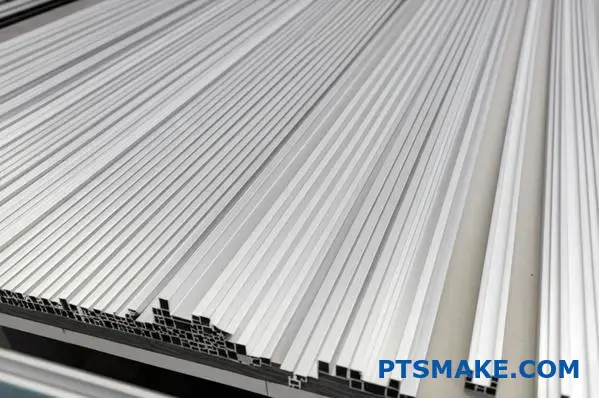
Monitor Key Performance Indicators (KPIs)
You can’t manage what you don’t measure. Define and track objective metrics.
Quality Metrics
Monitor defect rates (PPM – parts per million), adherence to dimensional tolerances for your custom aluminum profiles, and finish consistency. Agree on how quality issues will be reported and resolved.
Delivery Performance
Track On-Time Delivery (OTD) rates. Consistent delays can significantly impact your production schedules. Understanding the supplier’s capacity and lead times is crucial here.
Responsiveness
While harder to quantify, track how quickly the supplier responds to inquiries, quote requests, and concerns. Slow communication can be an early warning sign.
Conduct Periodic Reviews and Audits
Formal reviews and occasional audits help verify ongoing compliance and capability.
Business Reviews
Hold quarterly or annual reviews to discuss overall performance against KPIs, review costs, discuss future needs, and address any strategic concerns.
Potential Audits
Depending on the criticality of the custom aluminum profiles, consider occasional process or quality system audits. This isn’t about mistrust, but about ensuring continuous improvement and verifying that agreed-upon standards (like those we uphold at PTSMAKE) are being maintained. This also helps assess their Supply Chain Resilience6 against potential disruptions.
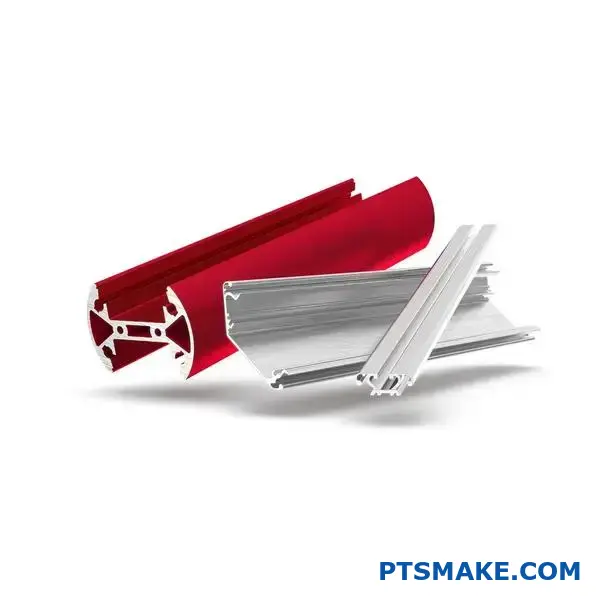
Foster Collaboration
Treat your supplier as a partner. Share relevant forecasts, involve them early in new design considerations for custom aluminum profiles where appropriate, and work together to solve problems. A supplier who feels valued is more likely to go the extra mile. Building trust, a core value at PTSMAKE, makes everything simpler and more effective in the long run. Consistent effort in these areas transforms a simple supplier transaction into a resilient, long-term partnership.
What Surface Treatments Are Available for Custom Aluminum Profiles?
Ever specified a finish for your aluminum parts, only to discover later it wasn’t quite right for the job? Choosing incorrectly can affect how your product looks and how well it lasts.
Common surface treatments for custom aluminum profiles include anodizing (clear or colored), powder coating, painting, mechanical finishes like brushing or polishing, and chemical conversion coatings. Each method provides different aesthetic and protective qualities.
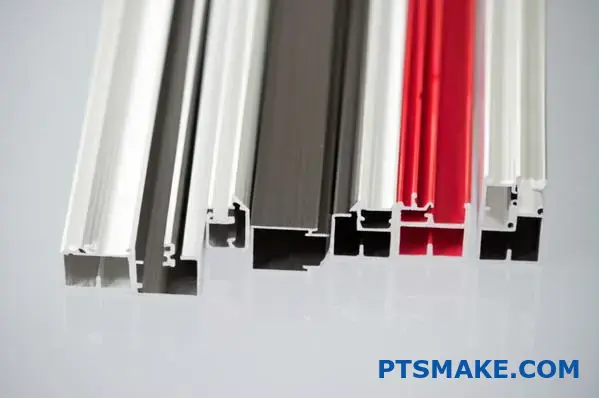
While raw aluminum has some natural corrosion resistance, surface treatments are often essential for enhancing durability, improving appearance, or adding specific functional properties to custom aluminum profiles. The choice depends heavily on the end-use environment and desired look. Let’s explore the main options we frequently discuss with clients at PTSMAKE.
Anodizing
Anodizing uses an electrochemical process to create a thicker, controlled oxide layer on the aluminum surface. It’s integral to the metal, not just a coating on top.
Clear Anodizing
This enhances the natural metallic appearance while significantly boosting corrosion and wear resistance. It’s popular for architectural and consumer electronic parts.
Color Anodizing
Dyes can be added during the process to achieve various colors, from black and bronze to vibrant hues. The color is sealed within the anodic layer, providing a durable and attractive finish.
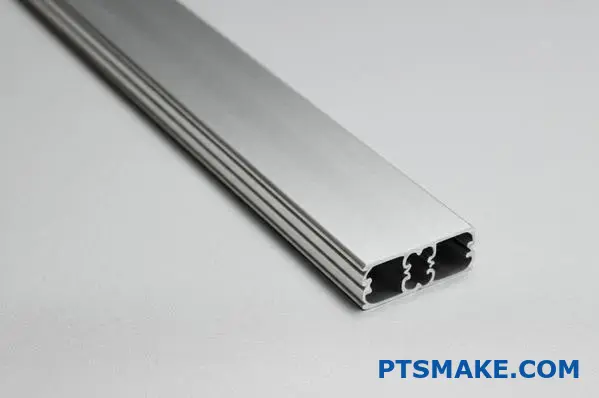
Organic Coatings
These involve applying a layer of organic material to the surface.
Powder Coating
Dry powder is electrostatically applied and then cured under heat. It creates a thick, durable, and uniform finish available in a vast range of colors and textures. It’s excellent for corrosion protection and impact resistance, widely used for outdoor furniture and automotive parts.
Liquid Painting (Wet Coat)
Similar to powder coating in terms of color variety, liquid paint offers different application methods and can achieve specific appearances. It provides good protection but might be less chip-resistant than powder coating in some scenarios.
Electrophoretic Deposition7 (E-Coating)
This process uses an electrical current to deposit paint. It provides excellent coverage, including complex shapes and interior surfaces, often used as a primer or a standalone finish.
Mechanical Finishes
These treatments modify the surface texture through physical means before other coatings might be applied.
Brushing
Creates a unidirectional satin finish with fine lines. It’s often used for decorative purposes on appliance panels or architectural trim.
Polishing
Results in a smooth, reflective surface, ranging from a satin sheen to a mirror-like finish.
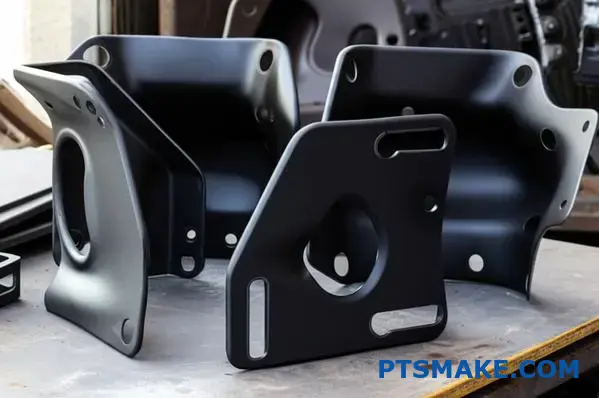
Chemical Treatments
These involve chemical reactions with the aluminum surface.
Chromate Conversion Coating
Applies a thin chemical film that improves corrosion resistance and provides an excellent base for paint adhesion.
Here’s a quick comparison of common choices for custom aluminum profiles:
| Feature | Anodizing | Powder Coating | Painting (Wet) | Mechanical Finish |
|---|---|---|---|---|
| Primary Benefit | Durability, Wear | Versatility, Tough | Color Options | Texture, Look |
| Corrosion Res. | Good to Excellent | Excellent | Good | Varies (Base) |
| Appearance | Metallic/Colors | Wide Color/Texture | Wide Color | Satin to Mirror |
| Relative Cost | Moderate | Moderate | Moderate | Low to Moderate |
Choosing the right surface treatment involves balancing aesthetics, performance requirements, and budget for your specific custom aluminum profiles. Consulting with experienced manufacturers like PTSMAKE can help navigate these options effectively.
What Are the Cost Factors for Custom Aluminum Profiles?
Ever received quotes for custom aluminum profiles that vary wildly? Unsure what genuinely influences the final price and how to manage your budget effectively?
Key cost factors for custom aluminum profiles involve raw material prices, profile design complexity, tooling (die creation), tolerance requirements, alloy/temper selection, surface finishing, order quantity, and any needed secondary processing.
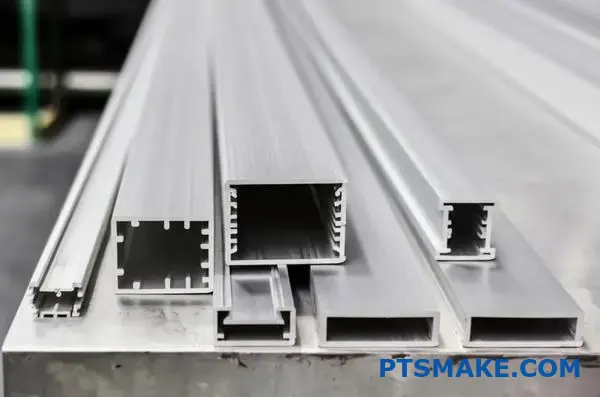
Understanding this cost breakdown is vital for good project planning and talking with suppliers. It’s not just about the weight of the metal; several factors significantly shape the final invoice. Let’s look into the key drivers I often discuss with clients at PTSMAKE, aiming for transparency and finding cost-effective paths for their custom aluminum profiles.
Raw Material Cost
This is frequently the biggest chunk of the cost. Aluminum prices change based on global supply and demand, often linked to market indices. The specific alloy matters too. Common alloys like 6063 or 6061 are usually less expensive than high-strength or specialized alloys because of ingredient costs and how easy they are to get.
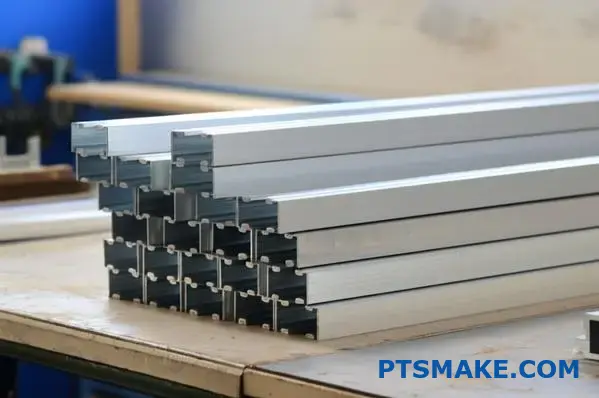
Profile Design and Tolerances
How complex is your profile shape? Designs with very thin walls, sharp inside corners, or many hollow sections need more advanced dies and slower extrusion speeds. This makes manufacturing harder and can increase waste, raising costs. Likewise, demanding very tight tolerances requires stricter process control and more quality checks, adding to the expense. It’s about finding a balance between what you design and what’s practical to make.
Tooling (Extrusion Die) Costs
Making the extrusion die is usually a one-time expense, sometimes called Non-Recurring Engineering8 (NRE). The die’s cost depends a lot on the profile’s complexity, size, and the type of steel used for the die. Simple dies cost less than complex ones. While this is an upfront cost, how long the die lasts affects the cost for future repeat orders.
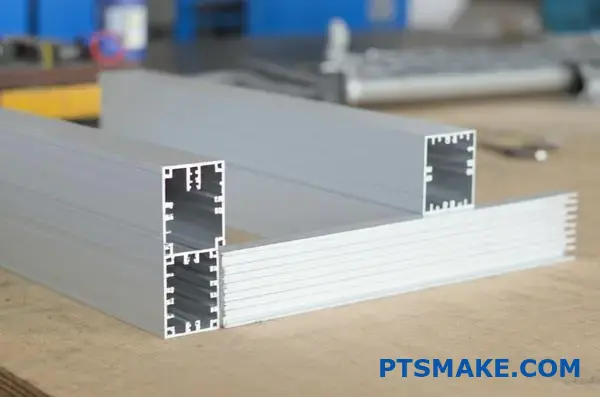
Surface Finishing and Secondary Operations
Do your custom aluminum profiles need a specific look or extra work after extrusion?
- Surface Finishes: Anodizing, powder coating, painting, or mechanical finishes like brushing add steps and costs.
- Secondary Operations: Cutting to length, drilling, tapping, CNC machining, bending, or welding add labor and machine time, affecting the price per piece.
Order Quantity Impact
Bigger orders usually mean lower costs per part. This is because setup times and tooling costs are spread over more items. Small prototype runs will naturally cost more per piece than large production volumes.
Here’s a simple look at how these factors generally impact cost:
| Cost Factor | Typical Cost Impact | Notes |
|---|---|---|
| Raw Material (Alloy) | High | Fluctuates with market, alloy type matters |
| Profile Complexity | Medium to High | Affects die cost and extrusion speed |
| Tooling (Die NRE) | Medium (One-Time) | Complexity is key driver |
| Tight Tolerances | Medium | Requires more process control & QC |
| Surface Finish | Low to High | Depends heavily on type and complexity |
| Secondary Operations | Low to High | Depends on number and type of operations |
| Order Quantity | High (Inverse) | Larger quantity often means lower unit cost |
Knowing these factors helps you have better discussions about your custom aluminum profiles project. You might find ways to lower costs without losing essential features.
Learn more about galvanic corrosion to prevent issues when joining different metals in your designs. ↩
Understanding Yield Strength helps ensure your components resist permanent deformation under operational stress. ↩
Discover how passivation enhances durability and finish options for your aluminum parts. ↩
Understand how precise measurement science impacts the final quality of your parts. ↩
Understanding NRE helps clarify one-time charges separate from per-piece costs in your quote. ↩
Explore strategies to build robustness against disruptions in your component supply. ↩
Click to understand this coating process better, enhancing your material selection knowledge. ↩
Learn about NRE to understand upfront charges separate from per-piece costs in manufacturing quotes. ↩


